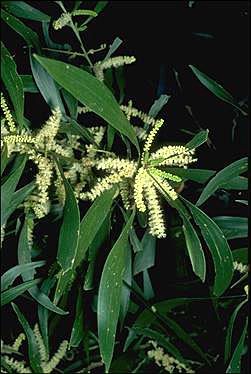Classification System: APG IV
Superregnum: Eukaryota
Regnum: Plantae
Cladus: Angiosperms
Cladus: Eudicots
Cladus: Core eudicots
Cladus: Rosids
Cladus: Eurosids I
Ordo: Fabales
Familia: Fabaceae
Subfamilia: Caesalpinioideae
Tribus: Acacieae
Genus: Acacia
Species: Acacia maidenii
Name
Acacia maidenii F.Muell., 1893
Synonyms
Racosperma maidenii (F.Muell.) Pedley
Distribution
Native distribution areas:
Acacia maidenii
Continental: Australasia
Regional: Australia
New South Wales, Queensland, Victoria
Introduced into:
Argentina Northeast, Florida, India
References: Brummitt, R.K. 2001. TDWG – World Geographical Scheme for Recording Plant Distributions, 2nd Edition
References
Primary references
Mueller, F.J.H. v., 1893. Macleay memorial volume, Linn. Soc. New South Wales 222.
Links
Govaerts, R. et al. 2020. Acacia maidenii in Kew Science Plants of the World online. The Board of Trustees of the Royal Botanic Gardens, Kew. Published on the internet. Accessed: 2020 Aug 07. Reference page.
International Plant Names Index. 2019. Acacia maidenii. Published online. Accessed: Aug 07 2019.
Tropicos.org 2019. Acacia maidenii. Missouri Botanical Garden. Published on the internet. Accessed: 2019 Aug 07.
Hassler, M. Aug. Acacia maidenii. World Plants: Synonymic Checklists of the Vascular Plants of the World In: Roskovh, Y., Abucay, L., Orrell, T., Nicolson, D., Bailly, N., Kirk, P., Bourgoin, T., DeWalt, R.E., Decock, W., De Wever, A., Nieukerken, E. van, Zarucchi, J. & Penev, L., eds. Aug. Species 2000 & ITIS Catalogue of Life. Published on the internet. Accessed: Aug 07 {{{3}}}. Reference page.
USDA, ARS, Germplasm Resources Information Network. Acacia maidenii in the Germplasm Resources Information Network (GRIN), U.S. Department of Agriculture Agricultural Research Service. Accessed: 09-Oct-10.
Vernacular names
English: Maiden's Wattle
Acacia maidenii, also known as Maiden's wattle, is a tree native to Australia (New South Wales, Queensland and Victoria). It has been introduced into India, (Tamil Nadu) and Argentina, and it grows on plantations in South Africa.[2]
Description and habitat
It prefers full sun to partial shade and it is often found on the edge of the rainforest.[3] It grows up to 20 m height in an erect or spreading habit.[4] The phyllodes are dark green, alternate along the stem and reach 20 cm in length and 1 to 3 cm in width.[5] It is very fast growing, reaching 1.5 m tall in as little as five months.[6] Its flowers have pale yellow spikes up to 6 cm long[5] that often occur in clusters of two to three.[7] The fruit is hairy, about 15 cm long and narrow,[7] often becoming coiled.[3]
In the Australian state of Victoria it is listed as being an endangered species,[8] however it is a common species through much of the rest of its range.[4] The tree has a lifespan of more than 30 years.[9] It grows approximately 1 m per year.[10] It is frost tolerant down to −7 °C[11] (about 19 °F), but it is not drought tolerant, so irrigation may be necessary in some growing areas.[6] In its natural range, it tends to grow in places with an average maximum temperature of about 25 °C, but it also exists in a range of 22–32 °C avg. max. temp.[12] It tends to grow primarily in areas near the coast averaging 1200–1600 mm/year of rainfall, but overall it is found to some extent in an areas ranging 600–2000 mm/year of rainfall.[12]
Uses
It makes an attractive ornamental tree along streets and in parks.[10] It is very good for reforestation in suitable areas. The exudates from the trunk (like gum or pitch) have been used in the past for food by indigenous Australians.[13]
Phytochemicals
Fitzgerald and Siournis reported in the Australian Journal of Chemistry (1965, volume 18, pp. 433–4) that a sample of the bark contained 0.36% of the hallucinogen dimethyltryptamine as well as 0.24% of N-methyltryptamine. However, anecdotal evidence suggests that the concentration of dimethyltryptamine and other tryptamines in A. maidenii is very variable and may be zero in some varieties. Older trees tend to have a higher percentage of dimethyltryptamine and more alkaloids are present after rain during summer, in the phyllodes, bark and root bark. Regardless, it is used as an admixture ingredient to nontraditional concoctions of ayahuasca, acting as a substitute for the traditional ingredient P. viridis.
Teracacidin, a flavan-3,4-diol, can be isolated from A. maidenii heartwood.[14]
Cultivation
USDA Zone 9 is recommended.[7] Acacia maidenii does well in all types of soil, except those that are waterlogged for lengthy periods of time.[10] The tree's seeds number about 65 seeds/g.[7] Acacia maidenii can be propagated from seed, but, in order to increase the germination rate, the seed should be treated first. It can be soaked in hot water or the seed can be nicked or otherwise mechanically scarified, so that water will penetrate the seed's hard coating and induce germination.
Germination is highest at temperatures between 21 and 27 °C.[15]
References
"Acacia maidenii". Germplasm Resources Information Network (GRIN). Agricultural Research Service (ARS), United States Department of Agriculture (USDA). Retrieved 2008-04-26.
"Acacia maidenii – ILDIS LegumeWeb". www.ildis.org. Retrieved 2008-05-06.
"Action Statement No. 36 – Maiden's Wattle". www.tacethno.com. Retrieved 2008-05-06.
"PlantNET - FloraOnline".
"Master List". Archived from the original on July 21, 2008. Retrieved 2008-05-06.
"Acacia Maidenii". 209.85.171.104. Retrieved 2008-05-04.[permanent dead link]
"Acacia maidenii from B & T World Seeds". www.b-and-t-world-seeds.com. Retrieved 2008-05-06.
Flora and Fauna Guarantee Action Statement State of Victoria Department of Sustainability and Environment, 2003
"Lycaeum". Archived from the original on 2007-05-27. Retrieved 2007-06-05.
"Acacia maidenii". www.metrotrees.com.au. Archived from the original on 16 May 2008. Retrieved 2008-04-26.
"Australian National Botanic Gardens – Growing Acacia". www.anbg.gov.au. Retrieved 2008-04-26.
"Australia's Virtual Herbarium Map Interface". www.rbg.vic.gov.au. Archived from the original on August 18, 2004. Retrieved 2008-05-06.
"Indigenous (Post Contact)". www.mountainstomangroves.org. Archived from the original on 2008-07-22. Retrieved 2008-05-06.
Flavan derivatives. XIX. Teracacidin and isoteracacidin from Acacia obtusifolia and Acacia maidenii heartwoods; Phenolic hydroxylation patterns of heartwood flavonoids characteristic of sections and subsections of the genus Acacia. JW Clark-Lewis and I Dainis, Australian Journal of Chemistry, 20(10), pp. 2191–2198, doi:10.1071/CH9672191
"Acacia maidenii in Profile". www.b-and-t-world-seeds.com. Retrieved 2008-05-06.
Retrieved from "http://en.wikipedia.org/"
All text is available under the terms of the GNU Free Documentation License


